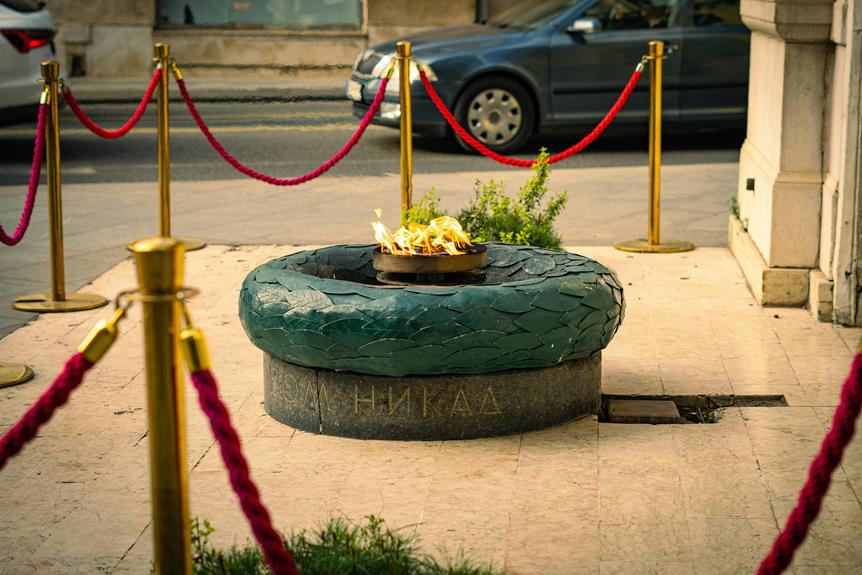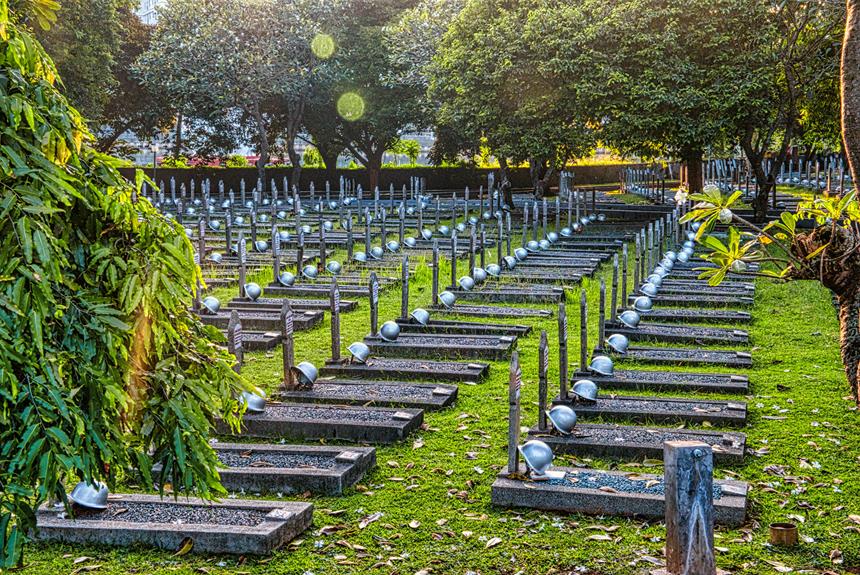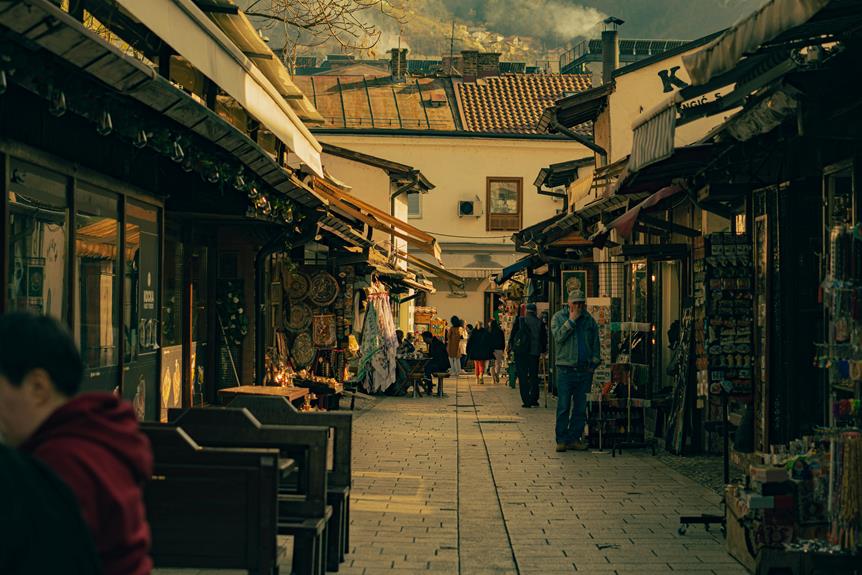The Kigali Genocide Memorial stands as a solemn reminder of one of the darkest chapters in human history. Beyond its architectural significance and educational value, the memorial holds within its walls stories of resilience, loss, and the enduring spirit of a nation working towards healing and unity. As visitors walk through its halls and gardens, they are confronted with the stark realities of genocide, prompting reflection on the complexities of reconciliation and the importance of preserving memory in shaping a more compassionate future.
Key Takeaways
- Architectural blend of modernity and symbolism.
- Immersive exhibits chronicle Rwandan Genocide.
- Interactive learning tools enhance understanding.
- Gardens and memorials symbolize remembrance and hope.
- Community outreach fosters reconciliation and healing.
History of the Genocide
The orchestrated genocide in Rwanda in 1994, marked by systematic violence and ethnic cleansing, stands as a tragic chapter in the nation's history. The causes of the genocide can be traced back to a complex interplay of historical, political, and social factors. Deep-rooted ethnic tensions between the Hutu majority and Tutsi minority, exacerbated by years of colonization and manipulation by colonial powers, created a volatile environment ripe for conflict. The assassination of President Habyarimana, a Hutu, in April 1994 served as the catalyst that triggered the pent-up animosities, leading to a state-sponsored campaign of mass killings targeting Tutsis and moderate Hutus.
The consequences of the genocide were devastating, with estimates suggesting that between 800,000 to one million people lost their lives in just 100 days. The social fabric of the country was torn apart, leaving deep scars that would take years to heal. The international community's failure to intervene effectively during the genocide raised questions about the responsibilities of the global community in preventing such atrocities.
The aftermath of the genocide saw Rwanda grappling with the immense challenge of national reconciliation and rebuilding a fractured society. The Kigali Genocide Memorial stands as a poignant reminder of the horrors of the past, serving as a beacon of hope for a future built on remembrance, justice, and unity.
Architecture and Design
Amidst the solemn backdrop of Rwanda's painful history, the Kigali Genocide Memorial's architecture and design stand as a powerful affirmation to the resilience and remembrance of a nation. The innovative structures of the memorial blend modernity with poignant symbolism, creating a space that not only honors the victims of the genocide but also serves as a beacon of hope for the future.
The architectural design of the memorial incorporates cultural influences, paying homage to Rwanda's heritage while also embracing a forward-looking perspective. The use of local materials and traditional building techniques intertwines with contemporary elements, reflecting the nation's journey from tragedy towards healing and reconciliation.
The layout of the memorial, with its carefully planned spaces and reflective areas, invites visitors to contemplate the past and engage with the stories of loss and survival. The integration of natural light and open spaces fosters a sense of serenity and contemplation, allowing for a profound and respectful experience.
Through its architecture and design, the Kigali Genocide Memorial not only commemorates the atrocities of the past but also serves as a tribute to the strength and spirit of the Rwandan people. It stands as a remembrance to the power of remembrance, offering a space for reflection, education, and the preservation of memory.
Permanent Exhibits
Within the Kigali Genocide Memorial, the permanent exhibits meticulously curate a narrative that chronicles the events and impacts of the Rwandan Genocide with a poignant blend of historical artifacts and immersive storytelling techniques. These exhibits serve as educational resources, offering visitors a deep insight into the tragic events that unfolded during the genocide and the lasting effects on Rwandan society. Through artistic presentations and curated displays, the memorial manages to convey the gravity of the genocide while honoring the memory of the victims.
To provide a clearer picture of the permanent exhibits, the following table outlines the key components of the displays:
| Exhibit Section | Description |
|---|---|
| Historical Artifacts | Authentic items from the genocide period |
| Interactive Media | Digital displays and videos enhancing visitor experience |
| Memorial Wall | Names of victims inscribed, paying tribute to their memory |
The use of historical artifacts helps to ground the narrative in reality, while the interactive media engages visitors and aids in understanding the complexities of the genocide. The Memorial Wall, inscribed with the names of victims, provides a poignant reminder of the human cost of the atrocities committed. Through these educational resources and artistic presentations, the permanent exhibits at the Kigali Genocide Memorial offer a moving and informative experience for all who visit.
Interactive Learning Experience
Engaging visitors through interactive learning experiences enhances the depth of understanding and emotional connection to the historical events recounted at the Kigali Genocide Memorial. The memorial offers a range of interactive tools and activities, including virtual tours and educational workshops. These resources provide visitors with a more immersive and engaging way to learn about the genocide that occurred in Rwanda.
One of the most impactful aspects of the interactive learning experience at the Kigali Genocide Memorial is the opportunity to listen to survivor testimonies. These personal accounts offer a firsthand perspective on the atrocities that took place and allow visitors to connect on a deeper level with the human side of the tragedy. Additionally, documentary screenings further supplement the educational experience by providing visual and auditory documentation of the events surrounding the genocide.
Gardens and Memorials
The architecture and layout of the Kigali Genocide Memorial incorporate gardens and memorials that serve as poignant symbols of remembrance and reflection. These elements are vital in providing visitors with a space for peaceful reflection and contemplation, aiding in the healing process for individuals affected by the tragic events of the genocide. The design of the gardens and memorials contributes immensely to the overall atmosphere of the memorial site, creating a sense of solemnity and respect for the lives lost.
- Symbolic Plantings: The choice of plants and flowers within the gardens holds symbolic meaning, representing themes of renewal, hope, and resilience in the face of adversity.
- Artistic Sculptures: Sculptures integrated into the memorial gardens evoke powerful emotions, conveying the pain and loss experienced during the genocide while also inspiring thoughts of unity and remembrance.
- Water Features: Water features such as fountains or flowing streams are incorporated into the design, symbolizing cleansing, purification, and the passage of time as part of the healing process.
- Communal Spaces: The layout includes areas for communal gatherings and ceremonies, fostering a sense of unity and solidarity among visitors as they pay their respects and engage in collective mourning.
Through the harmonious integration of gardens and memorials, the Kigali Genocide Memorial offers visitors a space for introspection, remembrance, and the ongoing healing process necessary for both individuals and communities affected by the genocide.
Community Outreach Programs
An essential component of the Kigali Genocide Memorial's initiatives includes the implementation of impactful community outreach programs aimed at fostering awareness, education, and reconciliation among diverse audiences. Through education initiatives and outreach programs, the Memorial actively engages with local communities to make certain the lessons from the genocide are not forgotten and to promote a culture of peace and understanding.
One of the key aspects of the community outreach programs is the organization of healing workshops and trauma counseling sessions. These initiatives are designed to provide support to survivors, families of victims, and communities still grappling with the aftermath of the genocide. By offering a safe space for individuals to share their experiences and emotions, the Memorial plays an important role in the healing process and in addressing the long-term effects of trauma.
Furthermore, the outreach programs extend beyond the physical boundaries of the Memorial, reaching schools, universities, and other institutions to educate the younger generation about the importance of unity, tolerance, and the consequences of division. By instilling these values early on, the Memorial aims to create a more inclusive society that is built on respect for human rights and a commitment to preventing future atrocities.
Visitor Information and Guidelines
Offering essential information and guidelines for visitors to the Kigali Genocide Memorial guarantees a meaningful and respectful experience at this significant historical site. When planning a visit to the memorial, it is important to adhere to specific visitor etiquette and make use of the educational resources available to gain a deeper understanding of the tragic events that transpired.
- Respectful Behavior: Visitors are expected to maintain a somber and respectful demeanor throughout their visit. This includes refraining from loud conversations, laughter, or any behavior that may disrupt the solemn atmosphere of the memorial.
- Photography Guidelines: While photography is permitted in certain areas of the memorial, visitors must make sure that they do so respectfully and without intruding on the privacy of others. Flash photography is usually prohibited to maintain the reverent ambiance.
- Guided Tours: Opting for a guided tour can enhance the visitor experience by providing additional context and insights into the exhibits. These tours are often led by knowledgeable guides who can offer valuable information and answer questions.
- Educational Materials: Take advantage of the educational resources such as informational brochures, audio guides, and documentary screenings available at the memorial. These resources can offer a more in-depth understanding of the Rwandan Genocide and its impact on the country.
Events and Commemorations
Events and Commemorations held at the Kigali Genocide Memorial serve as poignant reminders of the profound impact of the Rwandan Genocide and provide opportunities for reflection and remembrance. These events often feature survivor stories that highlight the resilience and courage of those who lived through the atrocities, showcasing their journey of healing and hope amidst immense loss and suffering. By sharing these narratives, the Memorial aims to honor the memories of the victims and guarantee that their stories are not forgotten, fostering a sense of collective remembrance and solidarity.
In addition to survivor testimonials, the Memorial organizes educational programs that explore the historical context of the genocide, aiming to educate visitors about the events that led to such widespread violence and devastation. These programs play an important role in raising awareness about the importance of preventing future genocides and promoting a culture of peace and tolerance. Moreover, through initiatives focused on reconciliation, the Memorial seeks to promote healing and understanding among different communities in Rwanda, fostering a sense of unity and shared humanity.
Impact on Rwanda Today
The enduring repercussions of the Rwandan Genocide resonate deeply within the fabric of contemporary Rwandan society, shaping its trajectory and societal landscape. Despite the passage of time, the impact of the genocide is still palpable in various aspects of Rwandan life.
- Reconciliation Efforts: Rwanda has actively engaged in reconciliation efforts to mend the social and emotional wounds inflicted by the genocide. Through community dialogues, truth, and reconciliation commissions, and grassroots reconciliation initiatives, the country is working diligently to foster unity and healing among its people.
- Trauma Healing: Recognizing the profound trauma experienced by survivors, Rwanda has implemented programs focused on trauma healing and mental health support. Counseling services, support groups, and mental health awareness campaigns aim to assist individuals in coping with the lasting effects of the genocide.
- Education Initiatives: Education plays an important role in shaping the attitudes and perceptions of future generations. Rwanda has prioritized education initiatives that promote unity, tolerance, and understanding. By revising curricula to include lessons on the genocide and its consequences, the country seeks to instill values of peace and coexistence in its youth.
- Social Cohesion: Building social cohesion is vital to ensuring a harmonious and inclusive society. Rwanda has implemented policies and programs that aim to strengthen social cohesion by promoting dialogue, cultural exchange, and mutual respect among different ethnic groups. By fostering a sense of national identity and belonging, Rwanda aims to prevent the recurrence of past atrocities.
Frequently Asked Questions
Can Visitors Bring Their Own Flowers to Place at the Memorial?
When considering memorial etiquette and the placement of floral tributes, visitors should adhere to guidelines provided by the memorial site.
While many memorials may allow visitors to bring their own flowers as a sign of respect and remembrance, it is crucial to verify this practice in advance to confirm that the tribute aligns with the site's protocols and cultural norms.
Understanding and respecting these guidelines can contribute to a meaningful and respectful commemoration experience.
Are There Any Special Ceremonies Held at the Memorial?
Memorial events play a pivotal role in honoring the past and preserving collective memories. Commemoration ceremonies serve as a poignant reminder of the sacrifices made and the lives lost.
These events provide a platform to reflect, educate, and unite communities in remembrance. By participating in these ceremonies, individuals contribute to the preservation of history and the promotion of peace.
Such gatherings hold immense significance in fostering understanding and promoting healing.
Is Photography Allowed Inside the Memorial and Gardens?
Photography rules and memorial etiquette are essential aspects of visiting historical sites. The guidelines prioritize respect for the solemnity of the space and the memories it preserves. Visitors are asked to refrain from taking photographs as a sign of reverence for the significance of the place and the events it commemorates. Adhering to these rules helps maintain a dignified atmosphere for all who visit.
These rules are put in place to ensure that visitors can pay their respects in a thoughtful and respectful manner. By following these guidelines, individuals contribute to the preservation of the memorial's integrity and the memory of those being honored.
Are There Any Volunteer Opportunities Available at the Memorial?
Volunteer opportunities at the memorial provide a meaningful way to engage with the community and contribute to preserving historical narratives.
Community involvement through these programs fosters a sense of responsibility and solidarity towards the memorial's mission.
These opportunities not only offer a chance to support important initiatives but also allow individuals to develop a deeper understanding of the issues at hand.
Engaging in volunteer work can create a lasting impact on both the volunteers and the community they serve.
How Are Survivors of the Genocide Involved in the Memorial's Activities?
Survivor involvement in memorial activities encapsulates a profound journey of healing and resilience. Through active participation in various initiatives, survivors not only honor the memory of those lost but also reclaim their narratives, fostering a sense of empowerment and community.
Their engagement serves as a proof to the enduring spirit of human strength amidst unimaginable tragedy, showcasing the transformative power of remembrance and collective action in the face of adversity.
Conclusion
In summary, the Kigali Genocide Memorial in Rwanda stands as a significant tribute to the victims of the 1994 genocide.
It serves as an essential educational resource for visitors.
One striking statistic to contemplate is that over 250,000 victims are buried at the memorial site, highlighting the immense scale of the tragedy.
This underscores the importance of remembering and learning from the past to build a more peaceful and inclusive future.


